#but it takes watercolour just fine in a simple sketching/doodling way which is how i use it anyway so
Text


<3
#started my new sketchbook !!#killing eve#villaneve#eve polastri#villanelle#sketchbook#watercolour pencils#watercolour#cupid and psyche#my art#<3333#paper is pretty thin cause they were out of sketchbooks and i picked a notebook instead#but it takes watercolour just fine in a simple sketching/doodling way which is how i use it anyway so#approved :)#(it's a dotted leuchtturm1917)
345 notes
·
View notes
Text
Drawings (1/1)
Summary: Killian hasn't drawn in ages. With Wish Hook's help and inspiration, he picks it up again.
Note: what is giving titles lol
anyways this is short and a bit silly but I had the idea and wanted to share!
Again, for clarification, I’m borrowing the idea used by other authors where “Killian” refers to OG Hook while “Jones” refers to Wish Hook.
Word count: ~1.3k
AO3
~
Killian passes the bag from Granny's to hang from his hook before he pushes open the main door of the sheriff's station. He takes the turn for the office and spots Jones sitting on one of the desks, occupied with writing.
"Hey, mate," he says.
Jones raises his head and gives him a smile. He then nods towards the storage room. "Emma's just finishing."
"Really? I thought I'd need to wait for her." He walks closer to Jones. Is that a notebook he's writing on?
Jones snorts a laugh. "She said your... our, punctuality is rubbing off on her."
Killian laughs. He's about to comment on how having two very punctual deputies would have that effect, but his attention is caught by what Jones is actually doing on the notebook.
He's sketching.
Killian doesn't realize he's transfixed by that simple sketch of a ship sailing on the open seas until Emma calls out to him. Neither her nor Jones seem to notice exactly how transfixed he was.
~
Killian "catches" Jones sketching again two days later, during a slow, lazy evening shift. Chin resting on his mechanical hand, he doesn't react when Killian stands up from his desk and steps closer. He's sketching the bare back of a female figure, her hands buried in her long, curly hair.
Killian takes a deep breath. His mind fills with memories of Milah posing for him to draw, of him for her to draw... though she always preferred drawing landscapes, painting people frustrated her, the only drawing of that kind that she didn't end up ripping being her own self-portrait. Had he known how early he'd lose her...
"I didn't know you kept up drawing," he says in a low voice.
Jones just shrugs. "I had a lot of time to spend alone in the tower, when Alice was asleep. I remember," he says, pausing on the sketch, "one of the first times I went for a supply run at the nearby village, I found some paper and charcoal, and decided to try picking it up again." He adds a couple of lines before adding, "My first attempts were pitiful. I tried sketching the tower room, the view from the window, my Alice sleeping in her crib. Eventually I just fell into it again. By the time Alice was old enough to draw shapes, I had practiced enough to reach the level I was in when I'd stopped." He turns to look at him and immediately grows worried. "Are you alright?"
Killian realizes how he must be looking. To Jones' eyes he's probably an open book. He sighs weakly. "I... I guess I hadn't realized I've been missing that."
Jones fidgets with the pencil in his hand. "It wasn't easy for me to start again, either."
The good thing with being friends with... himself is that a lot of things don't need explanation.
He remembered sketching as a kid; not so much during his time in servitude, then the occasional doodle when he was in the Navy, then it was with Milah that he spent the most time on it. She'd taught him techniques, let him copy her sketches for practice, posed for him to draw... and then she was gone, and any thought of going back on that hurt.
"But when I was thinking of how I had Alice to live for... it felt different." Jones picks up his phone from the desk and after a quick search, he shows Killian a series of charcoal sketches of a baby, then a toddler, then a small child.
Alice, he realizes.
Jones chuckles. "You could call those my 'baby pictures' of her. Alice told me she'd picked up all the sketches she could find in the tower before finally leaving, I had a few on my person but I lost them during my search for a cure..." His eyes fall as he looks at the pictures of the drawings.
Killian rubs softly on Jones' shoulder. "Good thing she kept those, then."
Jones smiles softly. He then straightens his face and looks up at him. "I could help you start again, if you want."
"Well, I-" Killian shrugs. "I do have the luxury of actual baby pictures."
Jones gives him a look that lets him know he's not buying the excuse. He clicks his tongue. "Fine. I don't mind excelling you at something other than our looks."
Killian scoffs, but he knows even that isn't convincing Jones.
~
Killian gives in only a few days later and invites Jones home one evening when Emma is off to inspect some troublemakers in the Land of Untold Stories while he babysits Hope. They start with Jones guiding him through sketching the vase filled with fresh roses in the living room.
Killian squints at the end product, but Jones reassures him he'll get better at it soon.
The living room. The view of the sea from the attic bedroom, the two Jolly Rogers moored next to each other. His Jolly Roger herself. The flowers Emma grows in their garden.
After a few sketches, Killian realizes he doesn't need Jones' guidance anymore. However, Jones accepts happily every time he invites him to come draw with him.
He finally draws Hope sleeping calmly, that thumb of hers trying to sneak its way past the pacifier to her mouth. As if she feels it, she only wakes up right when he's finished, and he's surprised to actually feel satisfied with the final sketch.
Jones scoffs playfully at him when Killian shows him the sketch.
"What? I think she looks beautiful," Killian says.
"Of course she does. Proves how much of Emma's looks she got," Jones teases him.
Jones laughs at the face Killian gives him.
~
His first time with watercolours, Jones takes him to the port to paint their ships.
"I started experimenting with colours for the first time when Alice was about three. I wanted to give her more colourful pictures of what she didn't have the chance to see on her own," Jones says.
"Great motivation," Killian comments.
"It made me think of all the colourful paints we'd find in all the exotic ports Milah loved, and why I had never bothered trying out painting with colours back then."
"Huh," Killian says as he prepares his palette by Jones' instructions. "I never thought of that myself."
"That's what I like about this, you know?" Jones looks at him with an earnest smile.
Killian knows he speaks for both of them when he says, "Getting to know ourselves better."
Once again, Jones lets Killian mimic his painting, giving him instructions throughout. He's not satisfied with the end result, but Jones assures him again that it's gonna get better.
"We didn't learn how to use a sword in one day, either," he tells him.
~
He eventually sticks to sketching, or pale soft colours when he does add them, in contrast to Jones' bright, vivid colours.
"It's interesting," Emma comments on that, "to see how you're still different despite being... almost the same."
"Well, we do have some twenty-eight years of different experiences," Killian says.
"You'd better not mimic my full experience, mate," Jones says.
"Are you kidding? I'll still be the more handsome when we grow old."
Emma scoffs. "I have an idea. How about you paint each other? You can compare the two paintings and decide which one has the most exaggerated ugliness."
"Now that's a competition," Jones says. "As long as Emma is not a judge."
"Are you afraid of losing, Jones?" Killian says.
"Just keeping it fair," he shrugs innocently. "It's your face she sees all the time; perhaps she's grown bored to it."
The pillow Killian was sitting on flies to Jones' direction as he and Emma burst into laughs.
32 notes
·
View notes
Text
speakers
Al Murphy
Website
Instagram
Tumblr
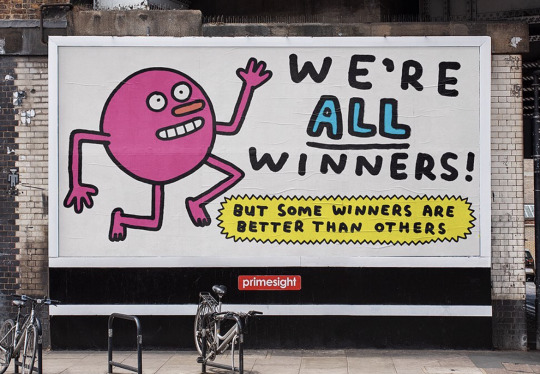
The main point of his talk, Al said, was to reassure those who are nearly graduating, were nervous or worried about our degrees or life as an illustrator, as well as how to make the jump between having graduated and having a job. He shared that he was very scared in his final year, “freaking out” and wondering how or when he would get a job or be employed. Al said he now has an agent, that gets him jobs, and this is the best route to go down. Jobs take all sorts of different forms (such as the one below!). Many of his jobs now are editorial, promotional or for advertising, and he mentioned he would love to do more animation but so far his career hasn't taken that turn.
His work, self-described, is usually character-based and humorous. Every aspect of his brand is bright, colourful and humorous too, including his website and his various social media. One quote from his solo show reads he’s been “described as the Ipswich Town FC of illustration”, in that “he’s been around for a long time but it’s hard to recall any of his major successes”, just an example of the kind of self-deprecating humour he uses in his work and his advertising. Another that also made me laugh was: “having spent ten years living in Berlin and New York he has recently returned to London where he spends his time telling disinterested others that he just spent the last ten years living in Berlin and New York”, which is relevant to our talk, and also funny.
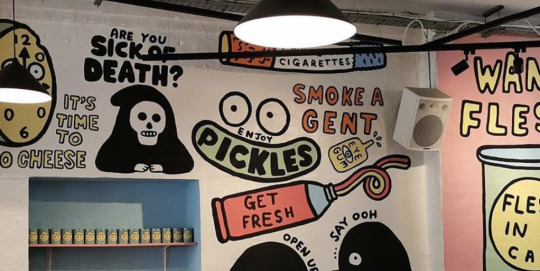
My own work rarely ever includes humour. It’s often character-based, however. I have never really thought about including humour in my work as it’s always been based on aesthetics for me, but it’s obvious that humour has a big hand in Al’s projects and how he gets employed for advertising. It could be worth trying this in future; seeing how humour can incorporate itself into my work.
Similar to Al’s work above, painted on a wall, is that of Sha’an D’Anthes. Although probably less about humour and focused more on ‘cute’ and aesthetically pleasing small illustrations, her work is similarly used below.
I have loved Sha’an’s work for years. I love the colourful nature of it - although the below illustrations on the glass are only in white, most of her work is bright and happy, like the first image. Personally I would love for my work to jump off the page in the same way, however the watercolours I mostly work with don't always allow this. I would like to work in more bright, colourful traditional ways and see how it translates.


Sha’an posts vlogs on her YouTube channel and documents her process, talking about life as an illustrator. It’s a fascinating insight into her career and I would love to do the same with my practice eventually.
Al spoke about his influences and how growing up, you don't always realise that something influences you as its happening. I thought this was an interesting reflection as I always find it quite funny to look back on my work from when I was younger and see how very similar it looked to a Disney Princess film! We collect plenty of influences over the years, all of which have an effect on our work.
Murphy’s work itself is very visually appealing; it’s easy to see why companies want to use it for advertising and promotions. It jumps out at you and is expressive and attention-grabbing.
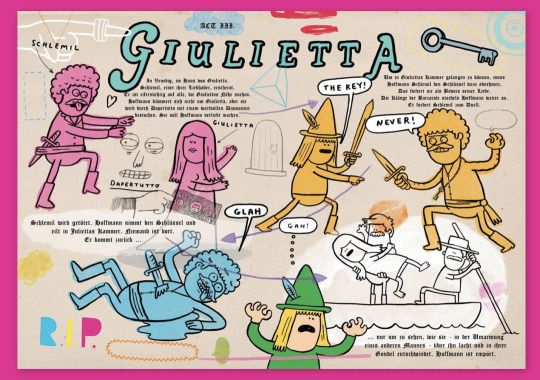
He described a few times about working with companies, big and small. Seeing as much of his work is advertising and promotions for companies, he has lots of experience with this. It’s always interesting to hear about working with brands and how the exchange works, especially as it’s likely I’ll experience this for myself after I graduate. I imagine it’s something you get better at through experiencing it for yourself, and you only really learn through doing, but it’s very useful to hear what companies expect from artists and the different ways they communicate it.
Although not from the talk, an article about Murphy in Creative Boom reads “on the one hand, [advertising] has fed and clothed his family and led to award-winning success, while on the other, it has made him question his own morals as he takes the money to help sell brain-melting products to children”. I thought this was a very interesting point as it is always relevant to discuss what we want from our careers and how we feel our talents are best used to affect the world around us. It’s not necessarily something that’s brought up often, especially as commercial illustration is a very popular road to go down and can be the source of quite a lot of money and success. There’s many other paths in illustration, however, and it’s always worth considering which options make you happiest, which ones you can get the most out of, or which ones you can contribute the most to. At the end of the day, I think creating for a living is a great privilege, and if you don’t love what you’re doing, it’s going to be very difficult to do it.

Simon Spilsbury
Website
Instagram
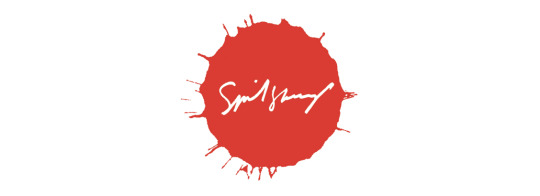
A freelance illustrator, Simon Spilsbury’s philosophy is that drawing, and ideas, are central to process. His website says that his work is “spontaneous, energetic, quirky, inherently humorous, adaptable and elegant”. At first, he said that every day there will be a new image, one that’s never been seen before. I thought this was a wonderful thing to start the talk with - a comment on creativity, and how it’s never the same twice.
He asked us, what sets you apart? In order to be creative, you must make collisions, and take your brain out of its comfort zone. I rarely do this; I’ve always stuck to what I know, especially as everyone says to be successful you need a specific style that people can recognise you by. In Simon’s words, however: “you never know where you're going to end up. If you do, you're not being creative.”

He stressed that your reaction to a brief only happens once. You should make a starting point, and the rest will follow. Personally this is something I struggle with; I find it really hard to bring myself to start something, as often the size of the task scares me. Usually once I’ve broken it down, it’s not so difficult.
Simon also had some specific illustration advice, a lot of it on emotion and expression. He advised that if you want to draw someone performing a specific action, you should do it first. The action also informs the rest of the image. If you're drawing somebody pick up a rock, for example, you draw the rock first.
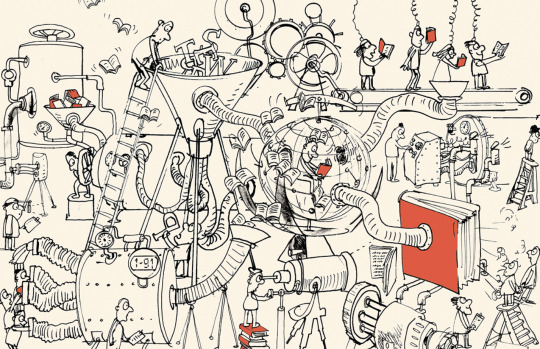
Simon’s practice is centred on drawing. Most of his work is sketchy and illustrative in a way only achieved through pen on paper, or digital pen on digital paper. It kind of captures the way that many artists sit down and absently doodle on a page, a bit like a stream of creativity.
I do most of my work through painting, or through digital software like Procreate. It’s very easy to capture the magic of drawing to Procreate now with very advanced software and plenty of traditional-style brushes. I don't think the emergence of this software changes the creativity that comes alongside drawing and art. Personally, in my head I separate quick, simple sketches on pieces of scrap paper from digital work or painted work as it might take less effort or time. Listening to Simon’s talk reminded me that maybe I shouldn't, seeing as both use lots of creativity. Arguably, quick sketches use more, seeing as they are thought up on the spot and require no planning, brainstorming or practice.
You must understand what you’re drawing, Simon says, with no preconceived ideas. I liked his approach to illustration - it was inspiring to hear about his version of creativity, especially as I haven't felt that creative in a while. My process has become sort of robotic, always the same, often on a screen and through a computer and rarely just for myself. Although Simon didn't address this directly, his ideas about creativity and leaving your comfort zone really struck home with me. I left wanting to do it much more often.
Neil Sheakey
Website
Instagram

Neil is a design director at Uniform, in Liverpool, established in 1998, which he described as one of the few companies outside London with a wide variety of creatives. He completed his degree in graphic design at the University of Derby in 2004. He showed us work his company had done with brands like Mitre, Ideal Standard, Innocent and Encona.

His personal creative process was broken down into stages: empathy, perspective, direction, creative and action. It’s always interesting to see or hear about other people’s creative processes, seeing how they differ to our own. Neil also introduced something else interesting, his idea of a 360 experience, also in stages. These were to see, hear, touch and feel, his way of trying out whether and how a brand connects to customers.
Most of Neil’s work is digital and for advertising. He placed a big focus on process, which I’ve not thought about for years. My A-Level Fine Art teacher drilled it into us that process is the most important part of a project. You need plenty of ideas and research to back up your work. I do this a lot for university projects, but not very often for personal projects. I would really like to try this for a personal project and are if it makes any difference to how much I like the finished product.
Neil gave us some useful advice about presenting. If your audience is frowning, it means they are concentrating, which is not a negative reaction. Presenting, he said, means talking about yourself and your ideas comfortably. However, if your idea bombs or does badly, ask questions: why? What can be fixed? How can it be better? I think these questions apply themselves very well to presenting but also to personal work, especially when I have produced something I don’t like (which happens a lot more than I’d prefer).

Most useful was Neil’s 10 tips. He didn't specify them as such, but they certainly are useful tips.
1. Explore - being creative is all about exploration.
2. Find your voice - something that is always talked about in the community.
3. Collaborate - I’ve learnt a lot about collaborating with others this year; people on my course, my friends, etc. It makes me more creative!
4. Think, do, reflect - always look back on your work and see what you liked, what you didn’t, what you can take forward from it.
5. Craft your portfolio - something I forget about! Having one online means people can always look at it, or stumble upon it.
6. Give 100% - I’ve got worse at this. I find it very difficult to motivate myself, but I’m trying harder, because this is something I love to do!
7. Value your time - I’m bad at time management, but my time is also precious, and it does well to remember that.
8. Look after yourself - one of the most important things, if not the most important one. Being creative for a living can be draining and also a lot of pressure. Looking after yourself is essential.
9. Be yourself - your creativity is what can get you jobs, commissions, etc. It’s important that it’s your own!
10. Enjoy it! - of course. Being creative for a living is fun! I’m not as good at this any more, as my whole life is creative now - when I was still doing exams, it used to be my escape rather than my degree, my hobby and my dream career. Hopefully I can get better at enjoying it and appreciating it.
Other Speakers
Due to illness, I unfortunately missed a couple of the speakers we had visit the university, and another was cancelled to to the COVID-19 pandemic. To fill in the gaps, found and listened to some more talks online.

Maria Kalman: The Illustrated Woman
This talk was wonderfully random and eccentric. Kalman seemed to really run with the idea of thinking outside the box and almost trusting your first thoughts. She talks of being a dreamy child and dreaming her way though life, all the way until college. Interestingly, Kalman didn’t start drawing until after university. I often worry about where I’m at professionally but I often forget that in the grand scheme of things, I’m still very young. The landscape of illustration is different now than in the 80s, but I still have a lot of my life ahead of me.
An interesting concept she mentioned was “if you know too much, you’re stymied”. This is the second talk this concept has appeared in: Simon Spilsbury also spoke about not knowing where you're going to end up, as if you do, it isn't creativity. Like I mentioned in his talk, this is something I am very bad at. I prefer knowing which direction I’m headed in and I’m often too nervous about a project and how it will turn out to even start it. This talk, and this point, was a brilliant reminder that you can’t plan everything, and sometimes your first thoughts are your best thoughts.
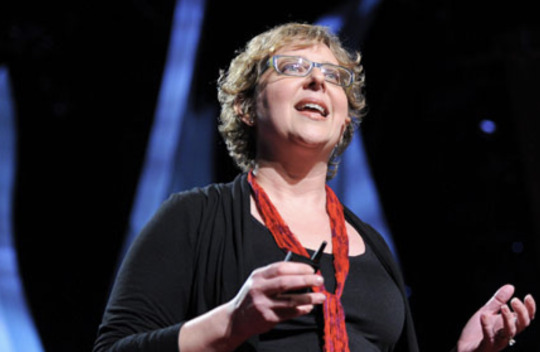
Janet Echelman: Taking Imagination Seriously
This was one of those talks where you think it might have changed your life, or at least your outlook. Janet Echelman went to India for an art show and her paints got lost in shipping. As I was listening to this story my heart dropped - I couldn't even imagine what I’d have done in this situation - but Echelman took it in her stride. On a walk, she saw the natives weaving nets on the beaches and sat with them to learn how to do it. Since then, this way of working has become her best and favourite way of working.
I was fascinated by this. As someone that is sometimes too intimidated to try a new type of paint, or to paint or draw a more difficult perspective of something, I found Echelman’s willingness to open herself up to new ideas inspiring. There have been plenty of obstacles in her creative life, but when those arise she simply found ways to solve them. There are often times when I find a challenge too hard, or too intimidating, to even start it. Deep down I know that if I attempt it, even if I fail, I will have learnt something from the experience, and you can only get better through trial and error. Even so, sometimes the nerves I feel about a new project or challenge can overwhelm this logic.
Echelman has carried out briefs for very important clients but despite this, her talk is still filled with the wonder and joy that sparked her creativity in the first place. She places great importance on how art should make you feel, and how you should strive to create things that make other people feel something too. It even made me tear up at the end.
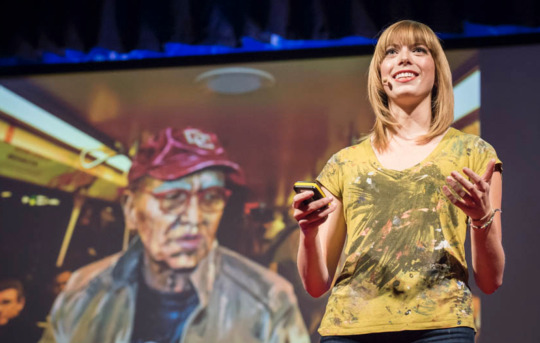
Alexa Meade: Your Body is my Canvas
A reoccurring theme with these talks for me is how good these creatives are at simply new ideas. I think the idea of creativity has taken a back seat for me over the years, and I know at A Level and GCSE there was a big focus on technical precision and talent instead of just having a good idea, and running with it. Although my degree places importance on elements of this, in my work it seems to have disappeared. Maybe creativity comes quite easily to me, in that I’m given a brief and instantly have ideas to put down, or maybe I've forgotten about it altogether, and I’ve managed so far to work without much of it. It might be that creativity is different for all of us. This talk still serves as a reminder that we should always be trying to access our creativity in everything we do.
Meade seems to have creativity down pat, however; if you could describe it, it would be this. Her work is fascinating in that she doesn't paint on canvas, but she actually paints on the subject she is painting. What comes from this is what looks like two dimensional paintings, but is all 3D. These talks are all inspiring, but Meade has taken an idea from the past and made it into a career that nobody else had done before.
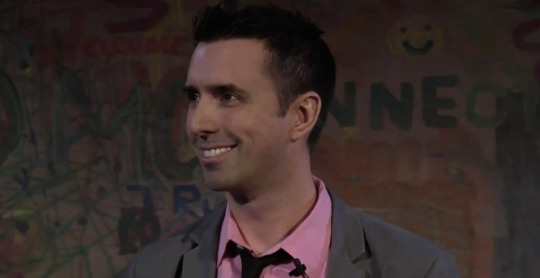
Jarrett J. Krosoczka: How a Boy Became an Artist
There is something so inspiring about holding art and creativity so close all your life, and Krosoczka’s story is this exactly. It places huge importance on using your imagination: “writing is using your imagination on paper”. It was another wake-up call to be reminded that at the basis of what we do as creatives, we’re always using our imaginations.
“Celebrate your own style” is among the wisdom in this talk. Krosoczka had a turbulent life but recognises and passes on the importance of good stories, for children specifically. There is a confidence that is threaded throughout his talk and his life, almost like willing something into existence. Again, it’s inspiring to see someone with the confidence to know that whatever happens, it’s always possible to meet your goals and fulfil your dreams. In a creative career it’s easy to let adversity get you down, but it’s also amazing to look back on your life so far and celebrate the achievements you've made.
What I took away from this talk is a reminder that even if I feel down about my art or my abilities, I always have the tools to get better and develop. I think this is something always worth remembering.
A few other links to interesting talks/podcasts I found by artists:
Anthony Gormley in Conversation with Iwona Blazwick
Tracey Emin RA on her largest-ever text piece
Building a successful career as an illustrator with Furry Little Peach
RCA Talk with Subject Matter: Women Artists & A Brave New Art World
Béatrice Coron: Stories Cut From Paper
In Summary
All in all I enjoyed the talks. It was inspiring to get a fresh perspective on art, illustration and creativity, especially as we often seek out ideas similar to our own and flock to people that share them. Naturally it was useful and equally as interesting to hear from people established in their fields, how this came to be, and even how they felt - and now feel - about it.
It was also a bit of a wake up call as I know plenty of people, me included, tend to stay focused on the present and the work they're involved in right now, instead of making plans for the future and looking ahead. I don't think it’s advisable to plan out every aspect of my future, but I rarely think about it. It was interesting, fun and quite daunting to sit on the train on the way home from some of the talks and imagine a career that spans as long as some of our speakers. Maybe one day I’ll give a talk of my own!
One criticism I have with the talks is the lack of diversity. I understand it is difficult to get people in to give talks, but one thing I noticed as soon as we got a list of who was visiting was the lack of women on it. I was hoping to get more of an insight into women in the industry. Instead, this was something I sought out myself; the extra talks I needed were mostly by women. Of course the women giving these talks were equally fascinating and knowledgable.
This concerns other aspects too, not only gender, as it would have been interesting to hear from people from different backgrounds and different ethnicities, as all of the speakers we had visit were very similar in that respect. It’s interesting to hear from anyone in the field, but I’m sure people from different walks of life would have something extra interesting to add to their talk or something different in their story to share. Not only for me, for my own curiosity, but also for other students that come from somewhere different to me, somebody that might appreciate a different insight that they can relate to. It would be easy to feature this in a range of visiting artists.
I felt there could have also bee variety in types of illustration, as the talks I heard were mostly from those in advertising and promotions (of course, the two I missed due to illness may have been different). I know Louise Lockhart, the final talk that was cancelled, is a children’s book illustrator, and gives me all the more reason to be disappointed about missing it! There are so many different ways to use skills and experience in illustration and although advertising is a very common one, it would have been useful to have more variety in this aspect.
Of course, it’s always encouraging and refreshing to hear from established artists and to take away something from a talk. There’s always something you can learn. Even with the extra talks I needed, I felt more and more interested with every one I listened to, and felt encouraged to find and learn more. It strikes me that with platforms like YouTube and Instagram, where we follow and subscribe to fellow artists and creatives, we are doing the same, always wanting to find out more and learn from people around us and people we admire.
0 notes
Text
My name is Kate and I’m an artist based in beautiful County Kerry, Ireland. I was studying graphic design, advertising and fine arts, but that was ages ago. After finishing my studies, I worked as a graphic and web designer, where I did mostly digital work. A few years ago, I started to paint again. It was a kind of stress relief therapy for me.
About 2 years ago, I decided to try to make my art living and here I am now. It’s not easy as it seems to be, especially if you must mind house, 3 kids and be a public relation, production, sale and “god-only-knows-what-else” manager.
My biggest love now is watercolor, but sometimes I need a change so I go for oils or painting clothes or mugs or whatever.
I love to paint birds and wild animals, but recently I discovered amazing world of… fruits and really normal everyday things which go perfectly as a watercolor painting objects.
Usually I paint full size, “proper” paintings. But with the beginning of this year I’ve decided to make something different and more challenging. I’ve decided to go for everyday doodles in the sketchbook. I started very simple, 10mins a day for a sketch, but with time, believe me or not, I got addicted.
I’m already on my 4th sketchbook this year and I can’t stop thinking about it and painting next picture. And it’s not like a quick “whatever” doodle, it must be something, some story hidden in the picture.
Where the ideas for everyday paintings coming from? – you ask. That depends on a day I’ll answer. Sometimes, I have million of ideas in my head. I can get inspiration from anything that’s around me. That’s really amazing and I plan for a few days in advance. It’s a great feeling when you have something to wait for, some new idea which needs to be painted.
But some other days nothing wants to come out. Just struggle and frustration. The more I wonder what to paint the less these ideas suit me. What to do then? Do something different, something that will help you to clear your mind, what you never did but always wanted to try or just simply take a break and do nothing.
And with time, your struggle will pass and new energy will come. Honestly that’s a never ending story, smaller or bigger ups and downs, in every artist’s life. If none of my ways work for you, try to find your own way to overcome it.
What supplies do I use?
I started with Royal Talens Van Gogh watercolors. They’re pretty great and not so expensive. Now I’m using Winsor & Newton Artist watercolors and Golden’s QoR Watercolors, both of them are amazing, but still sometimes I’m coming back to Royal Talens.
Brushes? I went through many of brands: Kolibri, Da Vinci, Winsor & Newton, Cotman, Chinese traditional brushes and many of kinds: synthetic, natural, mixed. I love them all, but now I stick to Winsor & Newton series 7 sable brushes and my beloved Chinese traditional brushes.
Paper? Again, many brands I’ve tried and some I like and some don’t. My most favorite so far is Fabriano, any kind. And by “any” I mean really any possible kind of Fabriano paper you can find. All of them are amazing.
People tell me “I wish my paintings would be so good as yours, but I can’t do it.” I always say: “Everyone can paint or draw. All is in your head and your attitude. If you want to do something just do it. I wouldn’t be here where I am without years of practice and hard work. So get a piece of paper, pencil or brush and draw or paint, whatever, but do it, 10-30 minutes every day. And in no time, you’ll see how much you’ve improved.”
Kate Plum
Instagram
Facebook
RedBubble
GUEST ARTIST: "Where The Watercolors Happen" by Kate Plum - #doodlewash #WorldWatercolorGroup #watercolor #watercolour #animals My name is Kate and I’m an artist based in beautiful County Kerry, Ireland. I was studying graphic design, advertising and fine arts, but that was ages ago.
#animals#artist#featured#fruit#inspiration#Ireland#painting#sketchbook#watercolor#watercolorist#watercolour
0 notes